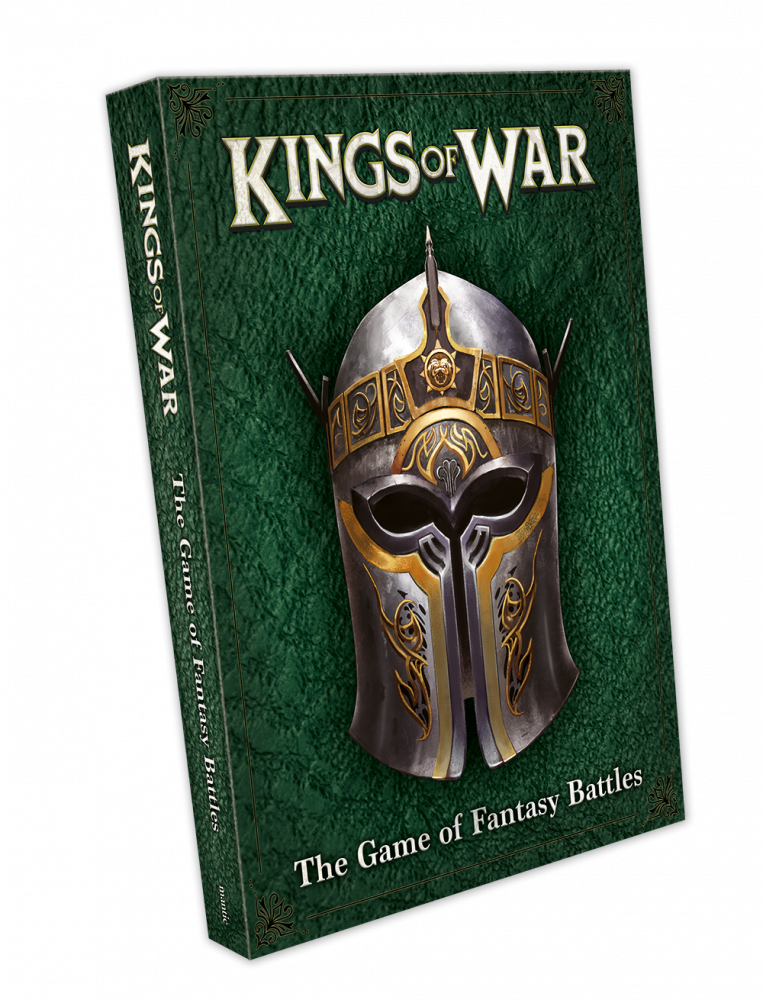The beauty of Kings of War is that there is no single winning tactic, and with all the units and army lists available there’s a large number of army styles at a player’s disposal. This allows for a huge variety in gameplay situations, helping keep Kings of War fresh and exciting game-to-game. Most of the factions in Kings of War can put together nearly any style of army, though some do it better than others. Indeed, there are some factions that literally do not possess certain unit types, such as Nightstalkers with war engines and Dwarfs with flying units. If you dream of dragons, don’t play Dwarfs.
In this article, we will describe what we consider the primary army styles, what they do, their strengths and weaknesses, and which factions can build them. Note that these are not mutually exclusive: For example, a flying circus could be considered a spam list or a monster mash, depending on what units make up the army’s flyers. Our goal is to give players – particularly those new to the game – a way to think about lists and identify potential ways that lists can be built, while being aware of those lists’ advantages and shortcomings.
Mixed Arms: Well-Balanced
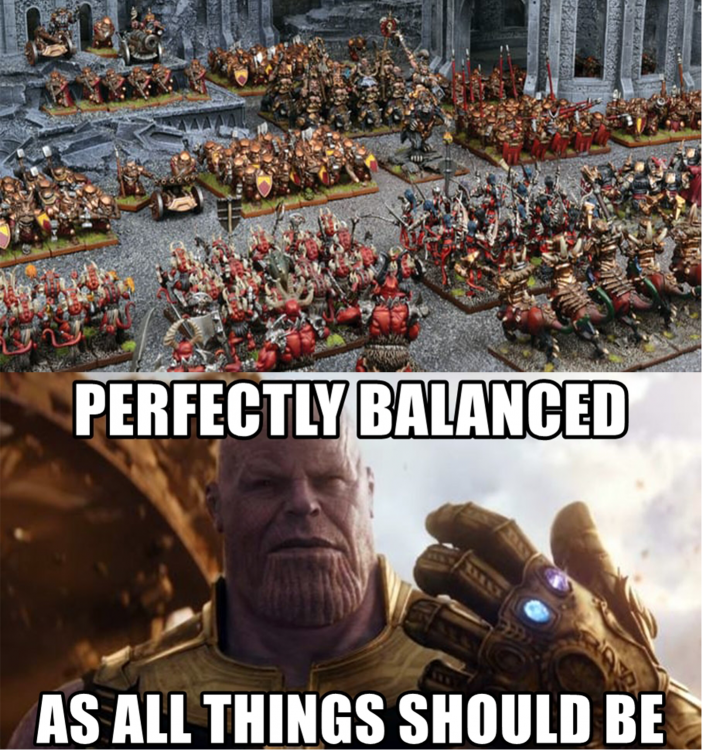
Mixed arms-style armies are probably what you think about when you picture an army that looks like an army. They tend to have it all; ranks-upon-ranks of infantry, ranged support, monsters and cavalry on the flanks, and characters to hold it all together. This is the default army, and every faction has the ability to field a mixed arms list.
The core of a mixed arms list are tougher units (anvils) that will stand firm and take the brunt of the enemy. The damage comes from the hammer units, which subsequently come down on the now-occupied enemy units, usually in the form of a flanking charge. There are few units that can survive being hit in both the front and the flank, and if any extra damage was achieved via ranged attacks, this all should result in one destroyed enemy unit. Anvil units need to be resilient enough to take an enemy charge without immediately routing, however damage output is not essential. Dealing damage is the job of the flanking hammer units, which generally require both punching power and speed (can’t afford to have the hammer come late).
The beauty of the mixed arms army is the flexibility of units that can be used, allowing you to use all your favourites, without compromising on winning potential. A mixed arms army also allows you to vary the composition of your army in different games, perfect for those that like to change models and units around. You can switch up your cavalry hammers to be monsters instead, or drop some warmachines and bring more wizards.
Mixed arms style armies are also the most beginner friendly. There are less moving parts in the army that need to go perfectly for the army to function. There’s also no pure counter army, so you’ll always have a chance to win.
All factions can build a well balanced army to a solid degree, and this style seems to be what Mantic have balanced the game around
Alpha Strike: All Hammers
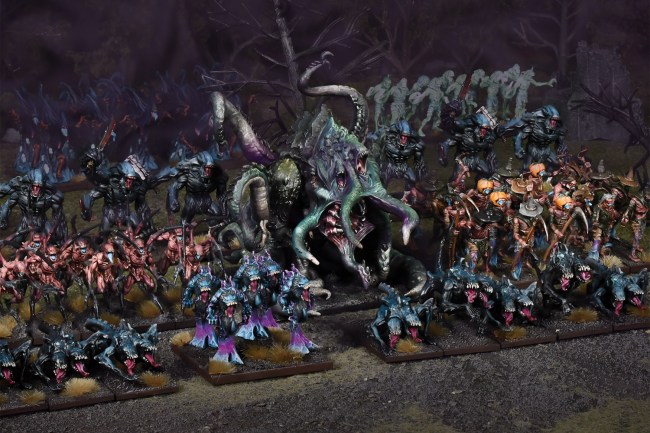
Leaning heavily into the “hammer” part of “hammer and anvil” philosophy, Kings of War has some units that can just put out horrific amounts of damage. Stuffing as many of these into a single force is considered an alpha strike army. These are usually the fastest and hardest-hitting units in the lists, relying on landing the first crippling blow and leaving your opponent at a deficit they can never catch up from.
Generally alpha strike armies are made up of fearsome cavalry and berserker-style infantry, which depend on getting the first punch and making it count. This is often at the expense of defense, hence alpha strike lists are relatively fragile (in comparison to a standard mixed arms). The phrase “The best defense is a good offense” epitomizes the strategy of alpha strike lists.
The specifics of what makes for good alpha strike units include at least a few of the following:
- A high amount of attacks (20+), here quantity is its own kind of quality.
- Good melee value (ie. Melee 3+), because hitting your opponent is important.
- Armour penetration (Crushing Strength or Thunderous Charge 1), so that even high-defense anvil units can be destroyed.
- High speed (Speed 7+ or Wild Charge), so that you can get those charges in early before your opponent is ready.
Nearly every faction has some fast, hard-hitting units, but the best alpha strike lists are limited to those that have multiple types of units that possess three or more of the above traits. The key is to overwhelm an opponent as quickly as possible, so having several units capable of doing so is integral.
Alpha strike armies usually excel at getting around the battlefield, hence scenarios involving board control (Control, Dominate and Invade) or objective markers (Pillage, Raze, Salt the Earth) control are in their favour. Holding loot tokens (scenarios like Loot and Push), however, is more difficult, as alpha lists do not want to hold back their units. There are a lot of options for an alpha strike list. Build of the Varangur and Orcs (lots of innate Crushing Strength), and the Knight-style focused builds from The Order of the Brothermark, The Order of the Green Lady and Undead (Crushing Strength or Thunderous Charge). There is also the Herd with lots of Thunderous Charge, and innate speed.
Dwarfs suffer in this regard, with most of their army having speed 4, and Goblins lack the ability to get through high defence with most of their units.
Grindy: All Anvils

In Kings of War there are a few notable units that just won’t die – at least not without concentrated efforts to remove them. When an army is made up of multiple of these units it is considered grindy, which refers to the seemingly never-ending amount of damage such tough units can take, as well as the gradual amount of damage these grindy units dish out.
Unlike the mixed arms armies, the best grindy armies don’t rely on flanking cavalry and are perfectly capable of taking the enemy out themselves. It just might take multiple rounds of combat to achieve. Hence the goal for such armies is to outlast their opponents in combat through sheer toughness, defeating the opponent’s key units so that they are left unopposed on the battlefield.
What makes a grindy army capable of this can vary among army lists, but usually involves a combination of the following:
- High defense values (ie. Defense 6), which directly impedes the enemy’s ability to damage your units.
- High nerve values (ie. 20+), so that in the event you do take damage, the unit is unlikely to rout.
- Special rules to avoid damage, such as the special rules, phalanx, big shield and ensnare.
- The ability to regain health points; special rules like Lifeleech and Regeneration can restore health, but the healing can also come from spellcasters casting Heal or Drain Life. It is important to note that healing requires your anvil to survive.
All armies have units with access to at least one of these to serve their standard anvil units, but it’s a unit that possesses multiple (or even all) of these traits that makes it truly capable of grinding it out with the strongest your opponent has to offer.
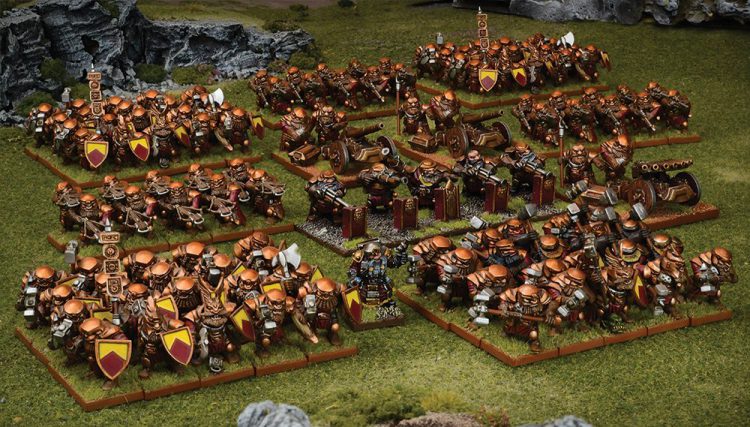
Regarding Kings of War scenarios, a grindy army varies in its performance. Unsurprisingly, the grindy list excels at holding Loot Counters (in scenarios Loot and Push). Similarly, scenarios that involve out-killing each other (Kill) play to the strengths of the grindy list. Where they struggle is getting around the battlefield quickly, as tough units tend to be on the slower side. Whether controlling particular regions of the battlefield (Control, Dominate and Invade) or getting to objective markers (Pillage, Raze, Salt the Earth), grindy lists can struggle.
Up there as the best grinding armies in the KoW, we have the Empire of Dust (high nerve and access to lots of healing), Dwarfs (naturally high defence) and League of Rhordia (lots of buffing units and phalanx). At the bottom of the pile are Goblins and Ratkin (low defence and nerve) and Nightstalkers (low defence), with the other factions in spots in between.
Monster Mash: All Thicc
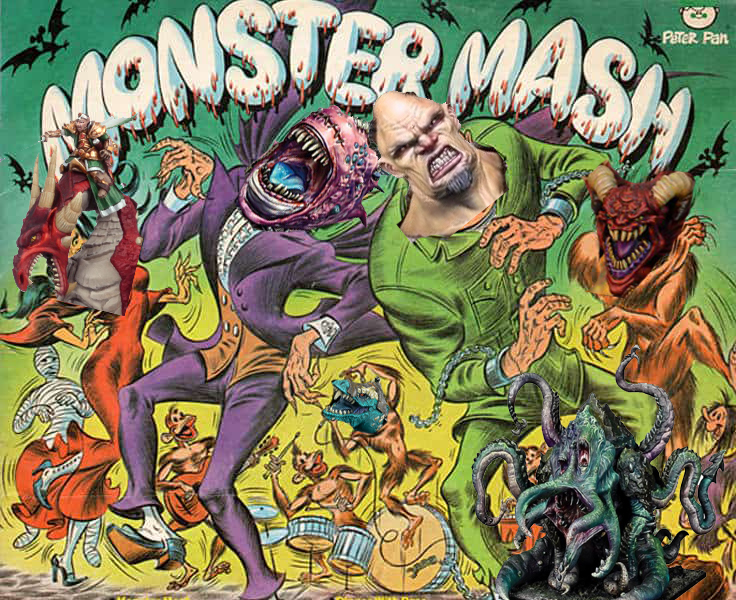
As the name suggests, a monster mash list involves mixing in lots of monsters to your list. Normally, adding a giant, a greater elemental or a dragon to your list gives it a bit of flexible punch in one part of the board, but the goal of the monster mash list is to spread that flexibility and punch across your entire army.
Monsters condense the hitting power of your army onto a smaller base, unlocking far more movement options in a game where movement is king. They typically are incredibly strong (Crushing Strength 2 or 3), but often have less attacks than infantry and cavalry. Despite the likelihood these attacks will do more damage (because they will!), the small volume of attacks means every failed roll is felt keenly. In addition, since monsters are so tall, they are quite vulnerable to gunline-heavy armies.
So, what makes for a monster mash army?
- Monsters (or Titans)! A pretty obvious one here, at least 3 to really set the scene
- Cheap troops. Got to have someone else to take the first hit for the big boys, as well as unlock them in army building.
Pretty simple, but to get a monster mash to the next level, some key support is needed in the form of:
- Ranged damage, to pick off the opponent’s annoying chaff so the monsters can hit the important things unimpeded.
- Healing, to keep the monsters going if they have to grind it out, kaiju battle style.
- Surge, to get those monsters into the fight faster and at nastier angles (flanks!). Not all armies get access to Surge so this last one is mostly for the elemental and undead monsters.
The monster mash list is not considered competitive as it struggles with any scenarios involving board control (6 of the 12 basic scenarios!). This is because what decides who controls objective markers or regions of the battlefield is unit strength. Big units (ie. hordes of infantry or cavalry) have much higher unit strength than monsters (3 compared to 1). Although a monster mash list will have its own infantry, it is likely any opponent will have more, and use this to their advantage in such scenarios.
Poor old Kingdoms of Men, they only have Mammoths and Giants as their big monsters, and Ogres barely have more. Unfortunately, they don’t have the Wow! Factor or intimidating effect as spamming as your Undead Vampire on Zombie Dragons (Undead), Mutant Rat-fiends (Ratkin) or Kraken (Trident Realms).
Gunline

The gunline army is one that focuses on getting nearly everything done in the Ranged Phase by taking as many ranged units, war engines and wizards as possible and pointing them at the unfortunate enemy. Despite these lists lacking any substantial melee component, there shouldn’t be much enemy left to fight following your terrible barrage.
They are similar to alpha strike lists, whereby damage is the entire goal of the army, however unlike alpha strike lists, a gunline army tends to sit relatively still, and do all its damage from a distance, instead of up close.
Every army has some form of ranged unit, but to make a gunline army you need:
- At least two war machine units, so that multiples can be brought to maximize likelihood of hits.
- Ranged infantry in hordes, to pump out weaker shots but also provide unit strength to hold objectives.
- Wizards with lightning bolt. Zzzappp!
- Chaff units, to get in the way and help you get an extra turn or two of shooting.
Gunline armies are perhaps one of the most infamous in Kings of War (and indeed in all tabletop wargames!) as they are often considered a one-sided affair. In Kings of War, however, they are countered by two major factors:
- The majority of scenarios require your units to move around the board to win (something gunline armies are reluctant to do, as most units are penalized for moving and then shooting).
- Nightstalkers and their army-wide stealthy special rule (-1 to hit from ranged attacks) will make your entire army (except lightning bolt-crazy wizards) 17% less effective.
These help ensure that any gunline army at least has to balance themselves out with some faster and more melee-centric units, if only just to scramble onto the objectives at the very end of the game.
If you want to be a good gunline, you better have good guns, or a lot of them. All Dwarf factions, as well as Goblins, Ratkin, Elves and Ogres all have varying ratios of many vs good guns.
On the other hand, Nightstalkers have no war engines, and one (pretty bad) non-magical shooting unit. Similarly, Varangur tend to be a get-in-your-face army, and skip out on the shooting to focus on the bashing.
Flying Circus

In a game all about movement being the fastest has its own special power, and when flying is added to the mix, a whole realm of opportunities to attack your opponent are unlocked. Fly up the sides to threaten the flanks, or leap over the enemy infantry to devour an unfortunate hero lurking at the back. The key is to do this over and over again without getting caught.
Flying units generally lack much defence, so getting the most out of a flying circus requires a measure of finesse. Fortunately, flying units are usually the fastest things on the board, having speed 10 (compared to the standard infantry’s speed 5 or 6). This basically guarantees the first charge goes to your flyers, and that means you’re the one controlling the engagements. The primary weakness of the flying circus is disordered, a status imposed when a unit takes damage which prevents them from flying. This means you will have to be wary of shooting and sneaky heroes (see below).
Most armies have access to at least one flying unit, but in order to field a flying circus-style force at least these key components:
- Hard hitting flying units, to not only take out key units of your opponent, but to also impose a ridiculous amount of consternation (no one wants to be on the receiving end of these).
- Cheap flying units (ie. flying chaff), to help set up charges for the above hard hitters, but also be available for cheeky flanking attacks.
- Flying heroes, to harass your opponent’s own flying units and prevent them from flying by making them disordered. That way you will be in command of the skies!
It is no surprise that with all this maneuverability, the flying circus army can do quite well in area control scenarios, so long as they are alive by the end of the game to make a move on objectives or regions. The control of loot tokens in certain scenarios is also where the flying circus can excel, as any loot token bestowed on a flying unit can be easily kept out of harm’s way.
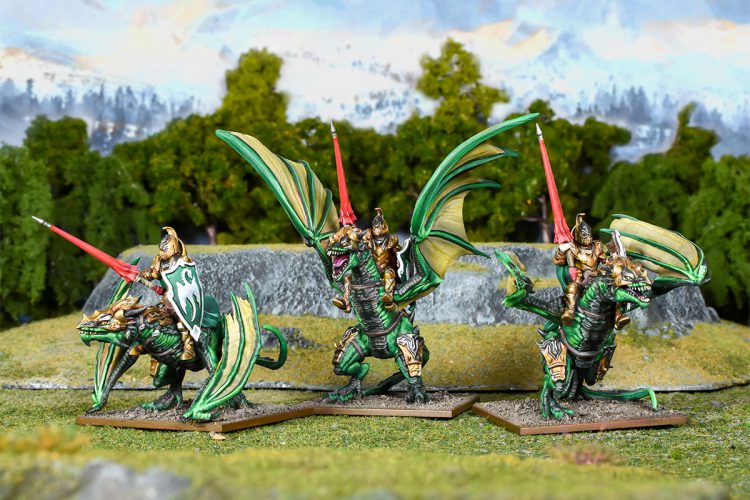
If you’re looking to make a flying circus army, you’ll want factions with either lots of distinct flying units, or one or two non-restricted flying units. Basilea has the Elohi and the hero Elohi as their main flying units (they have the option of mounting some heroes on dragons), while Forces of Nature have Air Elementals (greater and regular), Woodland Critters, Scorchwings, and Pegasuses (Pegasusi?). Unicorns and Beasts of Nature also have the option to be upgraded with wings.
Conversely, if you have no flying options (Dwarfs) or it’s only available on your hero’s mounts (League of Rhordia or Northern Alliance), you won’t really be able to reach the critical mass of flyers it takes to be a flying circus army.
Horde: Lok’tar ogar!
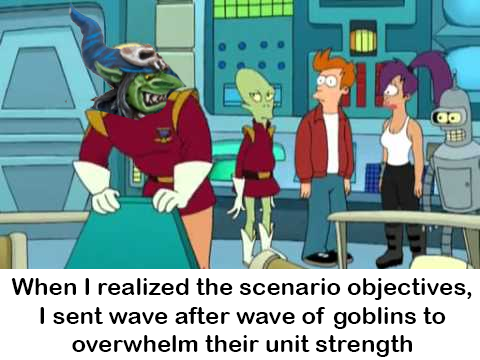
Horde armies are the cheap answer to the alpha strike and gunline armies – if the enemy objective is to kill, bring more units than could possibly be destroyed in 6 turns and overwhelm them. The opponent’s nasty monsters might do damage, but they will be stuck for far longer than they would like turning goblins, ratkin or zombies into jam, which is better than attacking your more vulnerable units.
Considering you’re bringing a lot of the worst units in your faction, you will struggle on the killing side of things. Often damage instead comes from wizards and war engines, made safe by the high volume of bodies between them and the enemy. But ultimately, dealing damage isn’t your priority, it’s just helpful if your opponent has some particularly nasty unit that might actually rip through your biggest unit.
To field a horde army you need:
- Cheap infantry hordes.
- More cheap infantry hordes.
- One more cheap infantry horde, to hold that back objective.
- Cheap heroes to keep it all annoyingly inspired (unless you’re Nightstalkers!).
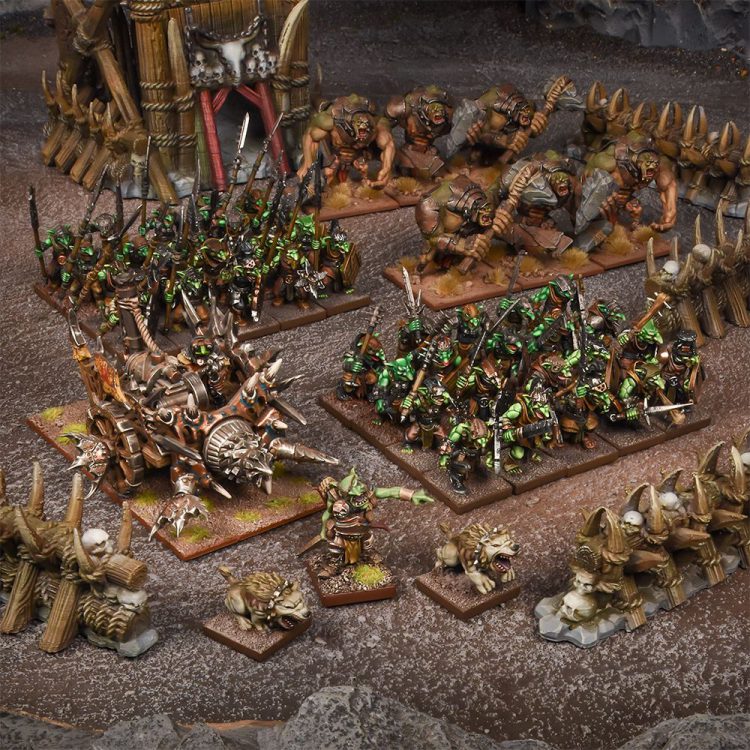
Regarding scenarios, what happens when basically your whole army is made of cheap units? Well, this style of list is essentially a board control one, so plays very well in missions that require holding objectives and table quarters, but not so much at getting through into your opponents deployment zone. Needless to say, you will be able to stop them getting to yours though.
Factions that play spam lists well are those with cheap, trashy troops, with Goblins being perhaps the best example. Undead, Nightstalkers and Ratkin are also up there for podium positions. As you would expect, if you don’t have cheap units, you wouldn’t be able to field a horde army, so Ogres, Elves and Dwarfs definitely lack in this department.
Summary
For those new to Kings of War, we recommend starting with a mixed arms style army. Fortunately, all the army and mega-army boxes offered by Mantic provide a good selection of units to build a mixed arms list (and they’re also fantastic value!). From this solid foundation, nearly every other style of army can be created with the addition of just a few more units (or in the case of goblins, a lot more).
The merit of Kings of War is that each of these strategies are a viable means to achieve victory, but none are capable of doing so by virtue of the units by which they are composed. In all cases it takes a competent general to get the most out of them, with some lists more than others requiring particularly careful planning and execution.
Have any questions or feedback? Drop us a note in the comments below or email us at contact@goonhammer.com.
